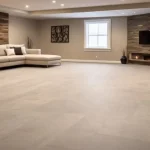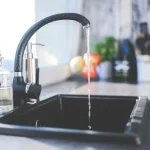Kitchen islands are a popular feature in modern homes, providing additional counter space and storage. If you’re planning to add a sink or dishwasher to your kitchen island, you’ll need to address the plumbing. Installing plumbing in a kitchen island on a concrete floor can be a challenge, but with the right tools and techniques, it can be done efficiently.
One common method is to use a jackhammer to create a trench in the concrete for the pipes. This allows for easy access to run the necessary plumbing lines. We’ll discuss the steps involved in installing plumbing in a kitchen island on a concrete floor, as well as some tips to make the process smoother.
Importance Of Kitchen Island Plumbing
Adding plumbing to a kitchen island can be a game-changer for the functionality, efficiency, and style of your kitchen. Here’s why kitchen island plumbing is more than just a convenience—it’s a smart investment in your home’s value, usability, and even energy efficiency.
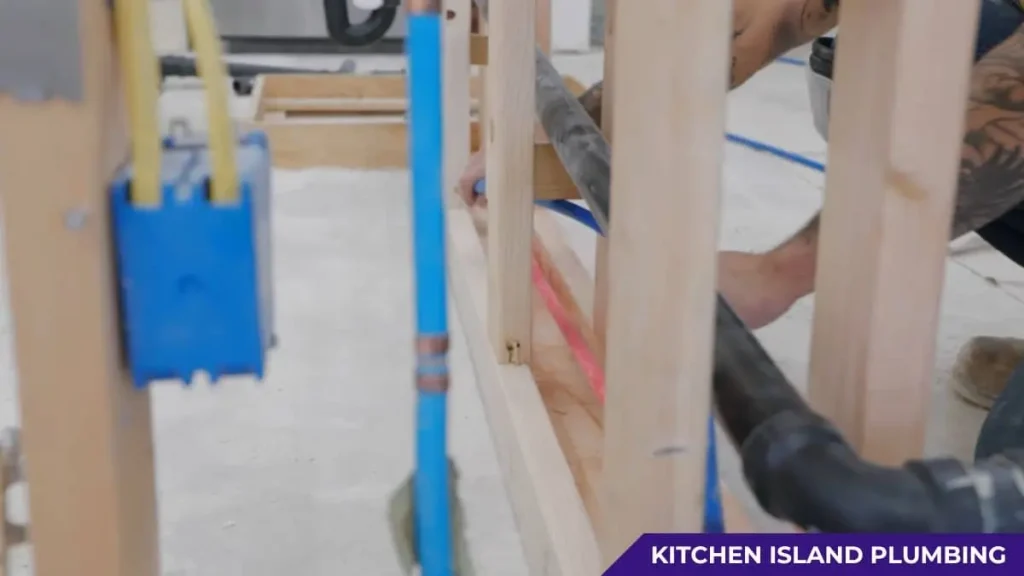
Enhanced Functionality and Workflow
A kitchen island with plumbing allows you to add a sink, dishwasher, or both, which can greatly improve the overall kitchen workflow. For instance, having a sink on the island gives you a secondary prep area for washing produce, filling pots, or rinsing dishes, which helps keep the primary countertop space clear. This is especially helpful in larger kitchens or open-concept layouts where multiple people may be cooking, prepping, or cleaning at the same time.
Improved Entertaining Capabilities
With plumbing, your kitchen island becomes a hub for entertaining. You can add a bar sink, a wine chiller, or even a filtered water station, giving guests and family members access to drinks and prep areas without disrupting the main cooking area. It’s a feature that not only boosts practicality but also creates a natural gathering space around the island.
Energy Efficiency and Water Conservation
A kitchen island sink can help reduce energy and water consumption. By strategically placing a sink on the island, you reduce the need to carry water across the room, minimizing spills, reducing cleaning, and ultimately conserving water. Additionally, if you install a high-efficiency dishwasher in the island, you can further reduce your water and energy usage, as newer models tend to be more eco-friendly.
Design Flexibility
Plumbing allows for design creativity in your kitchen island. Whether you’re designing a sleek, minimalist kitchen or aiming for a warm, rustic feel, the addition of a functional sink or other water features can be an aesthetic asset. It also enables you to rethink your kitchen’s layout by spreading out cooking, prepping, and cleaning zones, which can make even a smaller kitchen feel spacious and functional.
Added Convenience and Comfort
Having an additional sink at your kitchen island provides extra convenience, especially for busy households. It’s an ideal spot for quickly rinsing dishes, soaking pots, or washing hands while cooking. This saves you time and reduces the hassle of moving between the main kitchen sink and prep area, particularly if the primary sink is across the room.
Step-by-Step Installation Process
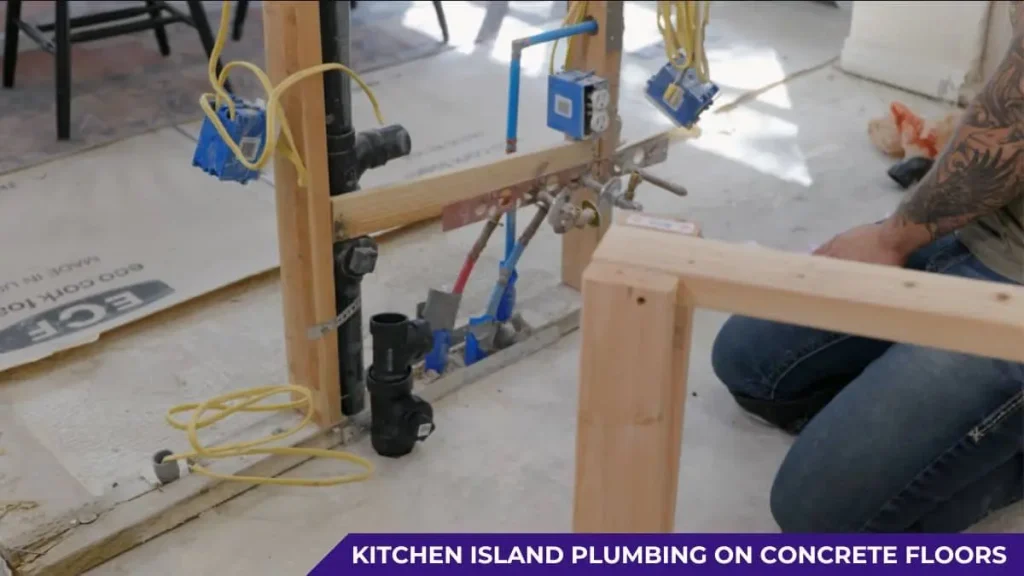
Adding plumbing to a kitchen island set on a concrete floor is a bit more challenging than on a standard wood subfloor, but it’s entirely possible with the right planning and tools. Below, we’ll walk you through the process to ensure your setup is both efficient and durable.
1. Plan and Mark the Plumbing Layout
Start by mapping out the layout of your kitchen island plumbing. Determine the placement of the sink and any additional fixtures, such as a dishwasher. Mark the exact spot where the water supply lines and drain pipes will be needed. Careful planning helps avoid costly errors and ensures that any excavation in the concrete will be minimal.
2. Confirm the Plumbing Code Requirements
Before breaking ground, review local plumbing codes to ensure that your design adheres to legal requirements. Common requirements include the pipe diameter, venting, and trap placement. Consulting with a licensed plumber at this stage can save time and help ensure the project passes inspection.
3. Mark the Concrete and Prepare for Cutting
Using a chalk line or masking tape, mark the areas where the trench will be cut. Ensure the lines are straight, and avoid cutting near structural supports or electrical conduits. The trench should be wide enough to accommodate both water supply and drain lines comfortably.
4. Cut the Concrete
Use a concrete saw to cut along the marked lines. For a cleaner cut, start with shallow passes and gradually deepen them. Make sure to wear protective gear, as cutting concrete generates a lot of dust. After cutting, use a sledgehammer or jackhammer to break up and remove the concrete within the marked trench area. Once cleared, you’ll expose the soil or gravel bed underneath.
5. Excavate the Trench
Dig a trench within the concrete slab that’s deep enough to accommodate your drain and water pipes while ensuring a sufficient slope for drainage (typically 1/4 inch per foot). This step is essential to prevent future drainage issues. Ensure the trench is level, smooth, and free of large debris.
6. Lay and Connect Drain Pipes
With the trench prepared, install the drain pipe first. Use ABS or PVC pipes designed for drain lines, and fit the pipes together with the appropriate elbows and couplings. Apply pipe primer and solvent to seal the joints properly. Verify the slope once more to confirm adequate drainage flow.
7. Install the Water Supply Lines
Next, install the water supply lines. PEX piping is often the best choice because it’s flexible, durable, and easy to work with, but you may also use copper or CPVC, depending on local codes. Run both hot and cold water lines to the appropriate locations and secure them with pipe clamps or hangers as needed. Make sure the lines are insulated, especially if your concrete floor is prone to temperature variations.
8. Connect Venting (if required)
In most cases, you’ll need to add a vent for proper drainage, which might mean running a vent pipe under the floor to connect with an existing vent or installing an air admittance valve (AAV) beneath the island. Venting is crucial for efficient drainage, so check with a licensed plumber if you’re unsure about the best venting option.
9. Pressure Test the Plumbing
Before you close up the trench, test the plumbing for leaks. Turn on the water supply and check for any weak connections in the pipes. This step is critical to avoid future problems with water damage. Additionally, pour water down the drain to confirm proper flow and that the drainage slope is adequate.
10. Backfill the Trench
Once the plumbing is successfully tested, backfill the trench with sand or gravel, covering the pipes evenly and ensuring they’re securely embedded. Use a tamper or heavy hand compactor to compact the fill material, ensuring there are no voids or air pockets that could compromise the concrete.
11. Patch the Concrete
Mix concrete according to the manufacturer’s instructions, and pour it into the trench, filling it to the level of the surrounding floor. Use a trowel to smooth the surface, blending it seamlessly with the existing floor. Allow the concrete to cure for the recommended time, usually 24–48 hours, before proceeding with additional work on the kitchen island.
12. Install the Kitchen Island
With the concrete cured, you’re ready to install the kitchen island. Follow the manufacturer’s instructions for mounting and securing the island to the floor. After the island is installed, connect the water and drain pipes to the sink or other fixtures, and verify that all connections are secure.
Cost Considerations for Kitchen Island Plumbing on Concrete Floors
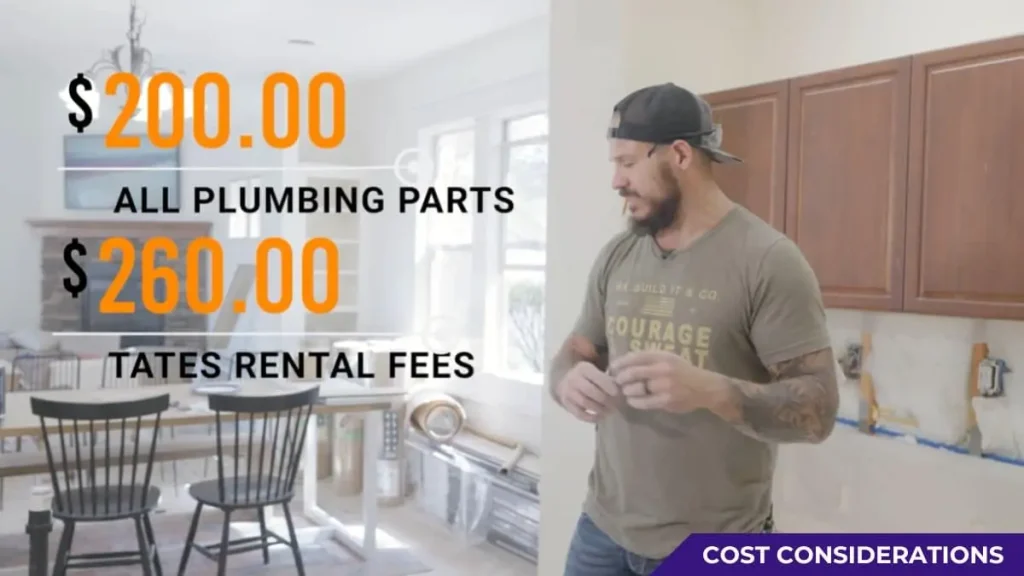
Adding plumbing to a kitchen island on a concrete floor involves various costs, from materials and labor to potential permit fees. Here’s a breakdown of what to expect and factors that may affect your budget.
Materials Costs
- Plumbing Pipes and Fittings: The cost of pipes depends on the material chosen—PVC or ABS for drain pipes, and PEX, CPVC, or copper for water supply lines. PEX is often the most affordable and flexible option for water lines.
- PVC/ABS (Drainage): $1–$3 per foot
- PEX (Water Supply): $0.50–$2 per foot
- Copper (Water Supply): $2–$4 per foot
- Primer, Solvent, and Sealants: $10–$20 for adhesives and sealants necessary to secure pipe joints.
- Additional Components: Items like elbows, couplings, shut-off valves, clamps, and hangers can add $50–$150, depending on the complexity of your setup.
- Air Admittance Valve (AAV): If your local code allows AAVs for venting, expect an additional $30–$50 for this component.
- Insulation for Pipes: To insulate water supply lines, especially important if your concrete floor is prone to temperature variations, budget around $0.50–$1 per foot.
Total Estimated Material Cost: $100–$500, depending on pipe type and kitchen layout.
Labor Costs
The complexity of trenching, pipe installation, and concrete work makes labor a significant part of the budget. Labor rates vary by region and contractor experience, but generally, the average is as follows:
- Concrete Cutting: Cutting and trenching the concrete floor costs around $50–$150 per linear foot. For a typical 5–10-foot trench, this cost can range from $250 to $1,500.
- Excavation and Plumbing Installation: Once the trench is cut, plumbers will charge for laying out and installing the drain and supply pipes. Plumbing labor costs range from $75–$150 per hour, and depending on the complexity, expect this part to take 4–10 hours. Thus, $300–$1,500 is typical for plumbing labor.
- Concrete Patching and Finishing: After the plumbing is set, the trench must be backfilled and patched with fresh concrete. Expect $5–$15 per square foot for this step. For a 1-foot wide trench over 10 feet, it could cost around $50–$150.
Total Estimated Labor Cost: $600–$3,150, depending on trench length, installation difficulty, and labor rates in your area.
Permits and Inspection Fees
Most municipalities require permits for any new plumbing work, particularly when it involves structural modifications like trenching concrete. Permit costs vary, but you should budget approximately:
- $50–$200 for plumbing permits
- $100–$300 for additional inspections if required
Total Permit Cost: $150–$500
Additional Costs and Contingencies
- Disposal Fees: Disposing of concrete debris may add an additional $50–$100, depending on local disposal fees.
- Ventilation Requirements: If you need to install a vent line that connects to an exterior wall or roof vent, this can add another $200–$500, depending on the distance.
- Professional Design Consultation: If the layout requires a design consultation or blueprint, factor in another $100–$300 for this service.
Total Additional Costs: $50–$900
Estimated Total Cost
Considering the above factors, here’s a general cost breakdown:
- Low-End Estimate: $900–$1,500 (simple installation with minimal trenching, no extra venting, and budget-friendly materials)
- Mid-Range Estimate: $1,500–$3,500 (standard materials, moderate trench length, and minor venting requirements)
- High-End Estimate: $3,500–$5,000+ (complex installation, premium materials like copper piping, extensive trenching, additional venting)
Cost-Saving Tips
- Choose Cost-Effective Materials: PEX and PVC/ABS pipes are often more budget-friendly without sacrificing quality.
- Minimize Trenching: Careful planning can reduce the length of the trench, saving both labor and material costs.
- Bundle Renovations: If you’re undertaking other kitchen renovations, consider bundling them to negotiate lower labor rates.
Tips For Ensuring Proper Functionality
Proper installation and maintenance of kitchen island plumbing on a concrete floor are crucial for its proper functionality. Here are some essential tips to ensure the efficient operation of your kitchen island plumbing system.
Proper Insulation
Ensure that the concrete floor is properly insulated to prevent heat loss and potential freezing of pipes. Use high-quality insulation materials to safeguard the plumbing system from temperature fluctuations and external elements.
Regular Maintenance
Schedule regular inspections and maintenance checks for the plumbing system to detect and address any potential issues promptly. Keep the area around the plumbing clean and free from any obstructions to facilitate easy access for maintenance tasks.
Conclusion
Installing plumbing for a kitchen island on a concrete floor may seem like a daunting task, but it can be done with careful planning and execution. It is crucial to consult with a professional plumber to ensure that the installation meets all necessary codes and regulations.
With the right tools and knowledge, you can have a functional and stylish kitchen island in no time. Don’t let the concrete floor hold you back from creating your dream kitchen.


